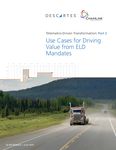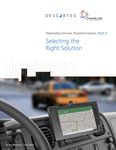Best Practices for ELD Mandates - Telematics-Driven Transformation: Part 1 M OFF - Barcoding-Canada
←
→
Page content transcription
If your browser does not render page correctly, please read the page content below
Telematics-Driven Transformation: Part 1
Best Practices
for ELD Mandates
M 2am 4am 6am 8am 10am N 2pm 4pm 6pm 8pm 10pm M
OFF
SB
D
ON
By Bill McBeath | June 2019Table of Contents
Telematics and ELD Mandates—Beyond Compliance....1
US ELD Mandate Already in Force.......................................2
Canadian ELD Mandate Enforcement Imminent..................3
Best Practices for Compliance and Beyond.....................4
Organizational Alignment...................................................4
Value Realization.................................................................6
Driving Continuous Performance Improvements..................6
From Burden to Benefit.......................................................6
Getting Value Now and in the Future............................7
Appendix A.......................................................................8
Impact of the ELD Rule on companies and drivers ..............8
Broader Impact of the ELD Rule...........................................9
This is the first in a three-part series
on the use of telematics to transform
performance in carriers and fleet
owning organizations.
Here in Part One, we look at the mandates and best
practices for them. Part Two explores value-add
use cases being adopted. Part Three discusses the
characteristics to look for in an ELD solution. The
research for this series included extensive interviews
with experts in both Canada and the US.Telematics and ELD Mandates Best Practices Getting Value Now and in the Future Appendix A
Telematics and ELD Mandates — Beyond Compliance
Electronic Logging Devices (ELDs) have thrust telematics into the limelight due to federally-mandated adoption
by US motor carriers and drivers, and soon by Canadian carriers as well. While owner-operators and many carriers,
especially smaller ones, at first resisted implementation of mandated ELDs, smart carriers and fleet owners are
figuring out how to leverage their investment in these devices to create considerable new value, once these
systems are in place.
What Are ELDs and HOS? Regulations require that ELDs:
An Electronic Logging Device (ELD) connects to a commercial motor • Let drivers log in and set their status as
vehicle to record the hours driven by each driver, to ensure compliance on-duty, off-duty, sleeper berth, or on-
with Hours of Service (HOS) regulations. HOS regulations limit the duty not driving
number of hours per day and per week a driver can drive and define • Display a graphical grid showing Record
the minimum breaks and hours of rest between shifts. The main of Duty Status (RODs)2
purpose of HOS is to reduce the number of accidents caused by driver
• Provide RODs data to regulators and
fatigue. ELDs replace paper logs (which were less reliable) and older
officers in a prescribed format
electronic devices (AOBDRs/EOBRs)1 previously used to record hours
driven. ELDs use data from the vehicle’s ECU (Engine Control Unit) via ELDs may provide other functionality
the OBD-II (onboard diagnostics) or similar interface, combined with above the minimum required by law. We
GPS data to reliably record when the vehicle is in motion and ensure further explore ELD functionality in part
that all hours driven are accurately accounted for. three of this series.
Figure 1. ELD Information Collected Throughout the Daily Driving Cycle; May Be Stored in a Cloud System
Logon, Change Status
to on Duty
Change Status to
Off Duty
Enter Inspection Info
Location for Proof
of e-Delivery ELD-related
Information Stored
in the Cloud, for Example:
ELD Base Information
HOS logs
Vehicle Location History
Inspection and Maintenance
Malfunction or Tampering Info
For their own orders ELD Vehicle Information Supporting Documents For their vehicles, and loads,
Engine RPM Bills of Lading
the customer sees: Motion Status Itinerary
the dispatchers sees:
Major milestones (Packed, Mileage Dispatch Records Continous real-time location
Engine Hours and More Expense Receipts
Depart, Delivered) Alerts (Delays, Accidents, Potential
Mobile Comms and More
Alerts (Arriving Soon, Delayed) theft/diversion)
Precise ETA 2-way communications with
drivers
Location and
Vehicle Info
Roadside Inspection
Telematics-Driven Transformation – Part 1: Best Practices for ELD Mandates 1Telematics and ELD Mandates Best Practices Getting Value Now and in the Future Appendix A
US ELD Mandate Already in Force
In the MAP-21 Act, the US Congress mandated adoption of ELDs (Electronic Logging Devices) with the aim of improving
safety and recordkeeping efficiency. The idea is that, compared to the traditional paper logs (which can be easily
falsified), electronic logging of the actual hours a truck is driven will improve compliance with HOS (hours of service)
rules and reduce the ad¬min¬istrative burden of paper recordkeeping.
The Federal Motor Carrier Safety Administration (FMCSA) issued the ELD Final Rule3 on December 16, 2015. It requires
all Commercial Motor Vehicle4 (CMV) carriers that operate across state lines to equip their vehicles with ELDs.5 As of
December 18, 2017, CMVs can no longer use paper logs or logging software, but must use an ELD (or an AOBRD
installed prior to 12/18/17). As of December 18, 2019, all AOBRDs are no longer allowed; only ELDs can be used.
Figure 2. US ELD Rule Enforcement Timeline
FMCSA FMCSA Drivers Using Paper Drivers Using AOBRD
Releases Publishes Logs must Switch Devices Must Switch
Proposal Final Ruling to ELDs to ELDs
Mar 2014 Dec 10, 2015 Dec 18, 2017 Dec 16, 2019
2014 2015 2016 2017 2018 2019 2020
PHASE 1 PHASE 2 PHASE 3
201
Awareness & Transition Phased-In Compliance Full Compliance 9
Feb 16, 2016 - Dec 18, 2017 Dec 18, 2017– Dec 16, 2019 Dec 16, 2019
Source: Geotab Paper, Understanding the FMCSA’s Final Rule on ELDs
United States ELD Rule. The FMCSA’s ELD Final Rule (49 CFR Parts 385, 386, 390, and 395) requires ELDs on all
commercial motor vehicles. The rule specifies:
Transport Transport Canada All Drivers • If an ELD malfunctions, it must be
• The location of each vehicle must be • Carriers must retain, for six months,
Canada Releases Published (Paper Log and ERD users)
recorded at least once an hour.Final Ruling supporting documents containing repaired within eight days and drivers
Proposal Must Switch to ELDs
information to verify the RODs, such must immediately reconstruct on a
• Carriers
Dec must
2017 maintain RODs, Jun(Record
2
13, 2019 Jun 12, 2021 paper log the last seven days of driving,
as bill-of-ladings or other documents
of Duty Status), a recording of each
specifying origins and destinations, unless that data can still be retrieved or
driver’s status for every 24-hour period
2017 2018 2019 dispatch
2020 records, expense
2021receipts, 2022 was already sent.
with driver’s name/ID, dates, locations,
mobile communications (text, email, • Drivers can make edits or annotations
times, and driving status.
etc.), and payroll records. to records, but the original record must
ELDs must be able to transmit RODs PHASE 1 PHASE 2
•
• Carriers cannot pressure drivers to 202
still be maintained.
data using either a telematics approach Awareness & Transition Full Compliance 1
violate regulations. • Manufacturers of ELDs must test and
(web services or email) or a local Jun 13, 2019 – Jun 12, 2021 June 12, 2021
approach (Bluetooth or USB) in a • ELDs must be mutable when the driver certify their devices against the FMCSA-
FMCSA-defined standard format. is sleeping in the berth. defined standards.
Telematics-Driven Transformation – Part 1: Best Practices for ELD Mandates 2Releases Publishes Logs must Switch Devices Must Switch
Proposal Final Ruling to ELDs to ELDs
Mar 2014 Telematics and ELD Mandates
Dec 10, 2015 Best
Dec 18, Practices
2017 Getting ValueDec
Now and
16, in the Future
2019 Appendix A
2014 2015 2016 2017 2018 2019 2020
PHASE 1 PHASE 2 PHASE 3
Canadian ELD Mandate Enforcement Imminent 201
Awareness & Transition Phased-In Compliance Full Compliance 9
Feb 16, 2016 - Dec 18, 2017 Dec 18, 2017– Dec 16, 2019 Dec 16, 2019
In December 2017, Transport Canada published the proposed ELD mandate, similar to the US rule. The enormous volume
of cross-border trade between Canada and the US (almost $700B per year)—and the correspondingly large number of
trucks operating in both countries—provides motivation to keep the Canadian requirements similar to the existing US
regulations, so that cross-border carriers and fleet owners can more easily comply with both countries’ regulations.
The final rule was published on June 13, 2019. The rule requires carriers to implement6 ELDs by June 12, 2021. There is
no additional transitional period for drivers and vehicles already using ERDs, as there was in the 2017 draft rule. Vehicles
with existing AOBRD/ERD devices must meet the same 2021 deadline as those currently using paper logs.
Figure 3. Timing for the Canadian ELD Rule
Transport Transport Canada All Drivers
Canada Releases Published (Paper Log and ERD users)
Proposal Final Ruling Must Switch to ELDs
Dec 2017 Jun 13, 2019 Jun 12, 2021
2017 2018 2019 2020 2021 2022
PHASE 1 PHASE 2
202
Awareness & Transition Full Compliance 1
Jun 13, 2019 – Jun 12, 2021 June 12, 2021
The Canadian rule has a number of similarities and differences from the US rule, as shown below:
Similarities Canada’s Differences from US
• Enforcement two years after Conveyance (PC)—that are • US enforcement started • ELD must accurately track
publication of final rule. not counted toward hours of in 2017. Enforcement in deferred Off-Duty time.
service. Canada starts in 2021.
• The ELD interfaces with • ELD must allow entry of
the ECU/OBD-II port of the • Drivers are able to check, • Canada has no additional hours captured elsewhere
vehicle’s engine. edit, and annotate logs, but grandfather period, (such as, driving done for
cannot delete the original after the 2021 date, for another company).
• The ELD provides GPS
log. preexisting devices.
tracking. Drivers login to the • May email logs to an
device and set/change their • An on-screen display • No central system for officer’s email to view during
status. presents information for inspectors to use at roadside an inspection (province-
roadside inspection by like the US’s eRODS system. specific).
• Devices automatically
officers and regulators. Each province will have their
capture driving time, • ELD must allow drivers to
own inspection mechanism.
including when the vehicle is • Both ELDs can generate an switch between HOS rulesets
moving and the driver is not output file for inspectors, • Does not require capturing (e.g. US vs. Canada,
logged in. but the formats are the VIN number. property-carry¬ing vs.
different. people-carrying, different
• The ELD allows special • US ELD manufacturers self-
cycles, time zones).
driving statuses—Yard • Pre-2000 vehicles are register/certify. Canadian
Move (YM) and Personal exempt. ELDs must be certified by • Exemption for rental vehicles
independent testers. used less than 30 days.
Telematics-Driven Transformation – Part 1: Best Practices for ELD Mandates 3Telematics and ELD Mandates Best Practices Getting Value Now and in the Future Appendix A
Best Practices for Compliance and Beyond
Based on the experience to-date of US carriers and fleets, there are a number of best practices that can be
applied to ensure a smoother transition, minimize disruption and capacity loss, and maximum benefits from ELD
adoption. These can be grouped into:
1 Organizational
Alignment 2 Value
Realization 3 Driving Continuous
Performance Improvements
1. Organizational Alignment Policies and Procedures
Establishing a Vision, Goals, and Strategy Company policies and procedures need to be updated to
include telematics and ELD compliance, such as the process
It is vital that each carrier or private fleet company has a clear
for logging a driver’s status, doing inspections, maintenance,
vision for its ELD program. A steering committee consisting
and so forth. The policies should clearly indicate how the
of key stakeholders—fleet managers, operations, customer
ELD data will be used and what it must not be used for.
and driver representatives, and IT—should be formed to
Harassment using ELD data is forbidden by law and anti-
clearly define the goals, strategy, timeline, metrics/targets,
harassment policies should be clearly laid out. Policies
and expected benefits for all stakeholders. While the initial
requiring compliance and forbidding driving violations should
goal may be compliance with regulations, the longer-term
be unambiguously spelled out, along with consequences for
goals should include benefits and value beyond compliance
non-compliance.
(see below From Burden to Benefit, page 6). The vision,
rational, timeline, and expected benefits for all stakeholders
should be continuously shared and reinforced across the
organization.
Telematics-Driven Transformation – Part 1: Best Practices for ELD Mandates 4Telematics and ELD Mandates Best Practices Getting Value Now and in the Future Appendix A
Training
Training of drivers, administrators, and managers is essential
and should begin early in the implementation. Drivers should
be trained on the goals of the program, the importance of
compliance and consequences of non-compliance (for the
company and individual), how to prevent violations, how the
data will be used (and not used against them), how to use
the device and the driver’s app, and procedures for tracking
and editing HOS. Drivers need to understand the policies and
procedures. They should be strongly encouraged to not try
to deal with HOS limitations by trying to ‘beat the clock’ with
speeding or reckless driving.
Route planners and dispatchers should be shown how to
create HOS-compliant routes, accounting for potential
Communication and Buy-In—Helping Drivers delays. Managers should be trained on how to use the
Through the Adjustment Period system, dashboards, KPIs, and notifications. Critically, anti-
Communication and buy-in across the organization are harassment policies need to be clearly communicated and
critical to the success of ELD implementation. Frontline understood.
workers can rebel and undermine an initiative if they feel
threatened or don’t understand it. In the case of ELDs, it
is natural for drivers to be wary about ‘big brother’ tactics Incentives
if they don’t understand how the system and the data Clear compliance metrics should be set, such as for clean
it collects will be used. Nobody likes to be put under a inspection rates and violation rates. When the organization is
microscope. Furthermore, the ELD takes away the inherent ready to try for additional performance improvements, then
flexibility of the prior paper-based system, which let the value-add goals can be put in place, for example reduced
driver ‘stretch the rules’ a bit, such as when there was excess fuel consumption, reduced accident rates, or increased fleet
detention, to finish the job and get home.7 That is no longer utilization. Drivers and managers can be recognized and
possible with the ELD recording every minute with precision. rewarded for meeting or exceeding goals. When individuals
Therefore, it is essential to have a plan on dealing with this or units fall short of goals, the root causes should be
new reality. It is important to let drivers know that you have diagnosed and jointly resolved with the team. Some carriers
their back. The anti-harassment policy should be clearly and fleets have switched from paying drivers by the mile to
communicated to drivers, along with a confidential whistle- paying by the hour to incentivize safety first.
blower mechanism to use if the policy is not being followed
by management. A system should be put in place to ensure
that drivers always have somewhere to stop, instead of
being stranded. Show drivers that you are working with
shippers and consignees on reducing detention. Adjust
route planning to account for stricter rules enforcement.
Communications and dialog with drivers and operations
should begin well before implementation and continue, It is important to let drivers know
often, to keep reminding drivers and others of the goals and that you have their back. The
benefits of the program. Providing a mechanism for drivers
to express their concerns and grievances privately can help in
anti-harassment policy should be
identifying where some extra care (and possibly adjustments) clearly communicated to drivers,
are needed.
along with a confidential
whistle-blower mechanism to
use if the policy is not being
followed by management.
Telematics-Driven Transformation – Part 1: Best Practices for ELD Mandates 5Telematics and ELD Mandates Best Practices Getting Value Now and in the Future Appendix A
Start Implementation Sooner Rather Than Later along with the expected benefits and performance targets,
All of this takes time, starting with organizing the should be explored and defined. Examples of potential use
steering committee, setting vision and goals, setting cases and sources of additional value are detailed in part two
up training programs, evaluating and selecting devices, of this series.
apps, and software, acquiring, implementing and testing.
Organizations that wait until just before the deadline
will have to skimp on all of these and will pay the price.
3. Driving Continuous Performance
Furthermore, the benefits that can be had from value
realization can measurably outweigh the cost of the Improvements
program. It makes sense to realize these benefits sooner Defining and Monitoring KPIs
rather than later.
Each phase of the program should have a clear set of goals
and KPIs for measuring success. To enable monitoring
of progress, strong dashboard, alerting, and analytics
2. Value Realization capabilities should be considered during the evaluation and
Carriers and fleet owners that implement ELD merely selection of ELD devices and software. Dashboards can help
to comply are missing significant value generation managers and individuals monitor progress towards goals
opportunities. The ELD steering committee should be and identify areas that need more work. These might include
tasked with seeking ways to generate value from the things like fuel consumption, safe driving behaviors, HOS
ELD investment and creating a prioritized roadmap for compliance, fleet utilization, maintenance costs, and more.
implementing those plans. The first step in the roadmap ELD data can also be used to improve customer behaviors.
will likely be basic implementation for compliance ELDs can provide precise data about detention times, which
purposes. After that can be operational improvements and can be used to work with customers to reduce excessive
transforming the customer’s experience. New use cases, dwell times at customer facilities.
From Burden to Benefit
When ELD is implemented purely to comply with regulations, and no efforts are made to realize additional
benefits and value, then it can be a burden on carriers. Beyond the cost of the devices and ongoing
subscription costs, the ELD mandate effectively reduces capacity and lengthens transit times for those carriers
who previously ‘got away with’ non-compliance under the old paper-based system. The tightened capacity
has exacerbated the driver shortage, resulting in higher wage rates, though not necessarily higher total wages
for individual drivers.8
However, carriers and operators have an opportunity to claw back significant value from their ELD investment,
for a substantial positive ROI. There are many different use cases for driving value to carriers, fleet owners,
drivers, and their customers. In part two of this series, we explore in depth some of the key use cases for
driving value.
Telematics-Driven Transformation – Part 1: Best Practices for ELD Mandates 6Telematics and ELD Mandates Best Practices Getting Value Now and in the Future Appendix A
Getting Value Now and in the Future
Those who view the ELD mandate strictly as a burden without an upside, often delay implementation as
long as possible, and invest the least amount possible. That is shortsighted, as there is potential for a very
respectable ROI by making the right investments. You don’t necessarily have to pay a lot for the device
itself, but it pays to invest the time to create a vision of where you want to go and then do the homework
to select the best solution provider to help take you on that journey.
Those who have already bought an ELD device (that is most US carriers and fleets), can build on their
investment now, by expanding the services and value they are getting out of the system. Here are some
actions to generate value from your ELD investments, now and in the future:
Create a cross-functional steering committee … and bold vision!
If you don’t already have a cross-functional group to create a vision and roadmap, now is the time.
The value-add uses, where the real ROI is generated, requires a bold vision, support from the top,
and cooperation across the enterprise.
Driver outreach
It is critical to get buy-in from drivers and avoid a rebellion. Have healthy driver participation on
the steering committee, communicate often, listen to and address concerns. Change takes effort
for all, but that effort is worth it.
Find and partner with the best solution provider
There are many providers of ELDs and related software,
but they are not all created equal. Take the time to
find the right solution provider who you can partner
with to help you go the distance. In part three of this
series, we outline key characteristics to look for when
selecting a solution provider.
Don’t delay
In particular, Canadian carriers should not wait until
the last minute. The sooner you start, the more time
you will have to create the steering committee, agree
on vision and goals, set up training programs, evaluate
and select solutions, acquire, implement, and test. By
allowing enough time, the transition will be smoother,
and you can start learning, improving and extracting
benefits from your investment.
The same urgency applies to US carriers who are
still using AOBRDs. The December 2019 deadline is
looming. Waiting until the last minute is a recipe for
headaches—not having enough time to select the
right system or resolve all the inevitable transitional
issues that arise, potentially resulting in costly non-
compliance.
Telematics-Driven Transformation – Part 1: Best Practices for ELD Mandates 7Telematics and ELD Mandates Best Practices Getting Value Now and in the Future Appendix A
Appendix A: Impact of the ELD Rule on
Companies and Industry
Impact of the ELD Rule on Individual Companies and Drivers
Consequences of non-compliance
Drivers without an FMCSA-compliant certified ELD device are placed out of service for up to 10 hours. After that,
they may be allowed to finish their current delivery, but cannot be dispatched again until they install a certified
ELD device. The average failure to comply fine has been $2,867 per offense.9 On top of that are the loss of
revenue and towing fees. If investigators determine there is a pattern of non-compliance for a fleet, fines may be
assessed on every truck in the fleet.
Impact on CSA SMS scores
ELD violations can have a significant negative impact on the CSA score. There are 22 ELD violations10 that impact
the CSA score. Furthermore, ELDs can be used to monitor and improve driving habits, reducing the chances of
speeding tickets and other moving violations that can have a large negative impact on the CSA score. Shippers
and brokers often take into account a carrier’s CSA SMS score,12 as a measure of the carrier’s safety record,
when selecting a carrier for hire. Thus, carriers are incented to maintain a good score, not just because of
potential fines, but also because of the potential for loss or gain of business. Furthermore, CSA scores impact
the associated ISS (Inspection Selection System) score. A better ISS score increases the chances for a bypass at a
weigh station, saving the carrier time and money.
Insurance premiums
The CSA score (and thereby ELD violations) also impacts insurance rates. A higher CSA score (i.e. more violations)
can lead to higher premiums, and in some cases even denial of coverage. Conversely, a low CSA score can bring
lower insurance rates. In addition, some insurers are offering discounts on premiums for qualifying truckers who
voluntarily share their ELD data. These discounts can be significant for drivers/fleets whose ELD data shows they
drive more safely than their peers.
Significant carrier/fleet performance improvement opportunities ELD devices, combined with the right software
and process changes, has the potential to help carriers reduce fuel consumption, decrease maintenance costs
and breakdowns, improve driver safety, decrease cargo theft, improve fleet utilization, decrease dwell times, and
provide much better visibility to customers and all stakeholders. We discuss these in more detail in part two of
this series.
Reduced paperwork for drivers
Estimates of reductions in administrative work from the adoption of ELD vary from 15 to 45 minutes per day, per
driver. At a pay of $20/hour and savings of 30 minutes per day, that equates to about $2,000 to $2,500/year13 of
increased productivity per driver.
Telematics-Driven Transformation – Part 1: Best Practices for ELD Mandates 8Telematics and ELD Mandates Best Practices Getting Value Now and in the Future Appendix A
Broader Impact of the ELD Rule
HOS compliance improved
According to a study by three universities,14 HOS compliance
has improved since the mandate. The number of intentional
HOS violations dropped from 6.0% to 2.9%. For owner-
operators, HOS violations dropped from 10.7% to 6.0%
percent during strict enforcement. Large carriers’ violation
rates were already under 1%.
Accident rates virtually unchanged
Weekly crash rates changed from 1,717 crashes per week
before the mandate to 1,703 after, about a 1% reduction.15
However, owner-operators committed 35.3% more unsafe
driving violations after the rule went into effect.16 Without
that increase in unsafe driving, there may have been a
greater reduction in crashes.
Transit times increased, effective capacity reduced,
rates up
With stricter compliance to HOS rules, transit times
increased, particularly on 450-550 mile lanes, where transit
times increased by about 16%.17 Many of these have gone
from being one-day routes to becoming two-day routes.18
Overall loss of ‘market hours’ was about 3%.19 The demand
for truck capacity exceeded the supply, driving up rates
significantly (though the imbalance and rate increases were
not due solely to the ELD mandate).20 The increased rates
helped carriers absorb some of the reduction in capacity
and the cost of implementing ELD programs. Rate increases
moderated in the second half of 2018.
Carriers and shippers/consignees start to collaborate
Stricter adherence to HOS (driven by ELD adoption)
combined with tighter capacity has provided some impetus
for shippers and consignees to better understand the impact
their operations have on carriers’ performance and HOS
compliance. When tight capacity forces carriers to make
decisions on who to serve first, shippers are motivated to
try and become the ‘shipper of choice.’ While that balance
of power will shift as demand and supply fluctuate, ELDs
will continue to provide precise data about detention and
turnaround times at different consignees’ facilities. Those
metrics can inform dialogs between the parties on how to
decrease dwell times, for the benefit of all.
Telematics-Driven Transformation – Part 1: Best Practices for ELD Mandates 9Notes:
1
AOBDRs (Automatic On Board Recording Device) and 12
Progressive Insurance launched their ‘Smart Haul ELD’
EOBRs (Electronic On Board Recording) refer to older program in 2018, offering usage-based insurance to
recording devices that predate the ELD mandates and owner-operators and small fleets. It includes a minimum
specifications. These are compliant in the US until 3% discount on their existing policy. Additional savings
December 16, 2019. may be granted, based on how safe the fleets’ driving is
compared to truckers doing similar work.
2
RODs (Record of Duty Status) are a recording of each
drivers’ status accounting for 24 hours each day. Status 13
The figure would be higher for the fully loaded labor
may be on-duty, off-duty, sleeper berth, or on-duty cost or revenue contribution of the driver’s time.
not driving. For more details, see pages 18-20 of the
Interstate Truck Driver’s Guide to Hours of Service. 14
In this study, researchers from Northeastern U., U. of
Arkansas, and Michigan State examined millions of
3
The full text of the ELD Final Rule can be found here. driver inspections from January 2017 to September
2018 and looked at all the crashes submitted to the
4
The FMCSA defines a commercial motor vehicle as any FMCSA during then.
vehicle with a gross vehicle (or combination) weight
rating greater than 10,000 lbs., or designed to transport 15
A 2014 study by the Virginia Tech Transportation
9 to 15 passengers for compensation, or any vehicle Institute evaluated data from carriers on 83,000 crashes
designed to transport over 16 passengers; or any size and found that trucks equipped with ELD-like devices
vehicle used to transport hazardous materials. had 11.7% fewer crashes than those without the
devices. This could be a correla¬tion of the policies and
5
There are exemptions for vehicles older than model year culture at companies who invested in these devices,
2000, driveaway-towaway operations, and drivers who rather than a result of the device itself.
maintain duty status logs for eight or less days during
any 30-day period. 16
One theory about why the increase in unsafe driving
occurred is that, since owner-operators were less
6
This includes selecting, acquiring, and installing the compliant with HOS regulations before the ELD
ELDs, as well as testing and training drivers on using mandate, they also experienced the biggest impact
them. on their capacity due to the ELD mandate pushing
them to better comply with HOS regulations. Thereby,
7
Note, there are ongoing discussions about modifying some owner-operators may have tried to partially
the regulations to provide some flexibility in meeting compensate for this loss of capacity by speeding and
HOS requirements. The current US administration driving more aggressively. We would not expect a big
appears to be receptive to those kinds of modifications. change in accident rates for larger carriers when the ELD
mandates took effect, since they were already largely
8
Drivers paid by the mile, who ‘stretched’ the HOS limits compliant with HOS regulations. It should be noted
using the paper logs before the ELD mandate, are now that nationwide data analyzed by Vigillo found that
forced to strictly comply and thereby drive fewer hours speeding violations for the industry overall went down
and miles. Thereby, even with increased per-mile wages, dramatically upon implementation of ELDs.
their total pay may have shrunk. Drivers who were
already strictly compliant with HOS rules, likely saw their 17
According to a survey by Zipline Logistics. They
paychecks increase in 2018. also found transit times on 750 to 1,000-mile lanes
increased 10%.
9
Source: North American Transportation Association
(NTA). Fines range from $1,000 to $10,000 or more per 18
Stricter HOS compliance means drivers can no longer
offense. complete these routes in one day. Carriers have changed
their rates for these routes accordingly.
10
A spreadsheet listing all 22 violations and their severity
impact on CSA score can be downloaded from the CSA 19
Source: C.H. Robinson Worldwide, Analyzing the Impact
site here. of the ELD Mandate on Truckload Shipping.
11
CSA (Compliance, Safety, Accountability) is the FMCSA’s 20
In 2018, dry van and reefer spot rates were up 30%,
data-driven safety compliance and enforcement flatbed spot rates increased 25%, while contract
program. One of its core components is the Safety rates increased more than 15%. The supply-demand
Measurement System (SMS), which the FMCSA uses imbalance and rate increases cannot be attributed to
to measure the severity of safety issues, identify the ELD mandate alone. The economy, driver shortages,
carriers with potential safety problems, and prioritize and other factors play major roles. Analysts predicted
interventions required. the market will soften in 2019.
Telematics-Driven Transformation – Part 1: Best Practices for ELD Mandates 10Download part two & three
of the Telematics Driven
Transformation series below
About ChainLink Research
ChainLink Research, Inc. is a Supply Chain research
organization dedicated to helping executives improve
business performance and competitiveness through an
understanding of real-world implications, obstacles
and results for supply-chain policies, practices, processes,
and technologies. The ChainLink 3Pe Model is the basis
for our research; a unique, multidimensional framework
for managing and improving the links between supply
chain partners.
For more information, contact ChainLink Research at:
321 Walnut Street, Suite 442, Newton, MA 02460-1927
www.clresearch.com
info@clresearch.com
(617) 762-4040.
www.descartes.com
info@descartes.com
© 2019 ChainLink Research, All Rights Reserved.You can also read


























































